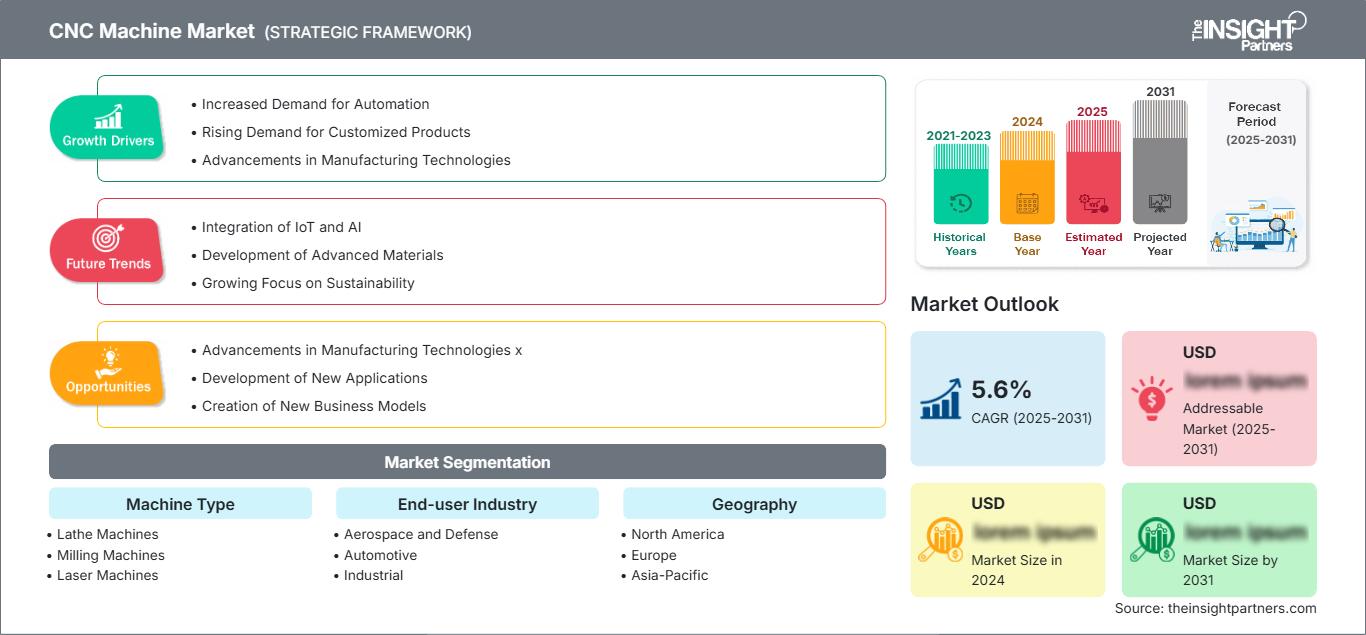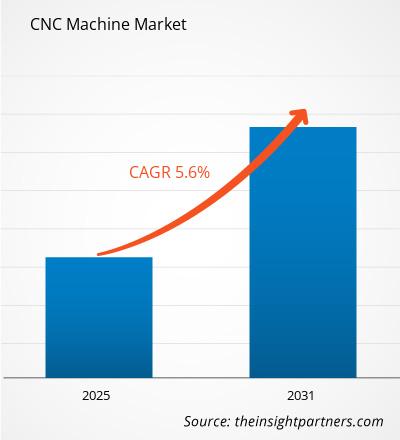Der Markt für CNC-Maschinen wird voraussichtlich zwischen 2025 und 2031 eine durchschnittliche jährliche Wachstumsrate (CAGR) von 5,6 % verzeichnen, wobei die Marktgröße von XX Millionen US-Dollar im Jahr 2024 auf XX Millionen US-Dollar im Jahr 2031 anwachsen wird.
Der Markt ist nach Maschinentyp und Endverbraucherbranche segmentiert. Das Segment Maschinentyp ist in Drehmaschinen, Fräsmaschinen, Lasermaschinen, Schleifmaschinen, Schweißmaschinen und Sonstige unterteilt. Basierend auf der Endverbraucherbranche ist der globale Markt für CNC-Maschinen in Luft- und Raumfahrt und Verteidigung, Automobilindustrie, Industrie, Metalle und Bergbau, Kraft und Energie und Sonstige segmentiert.
Zweck des Berichts
Der Bericht „CNC-Maschinenmarkt“ von The Insight Partners zielt darauf ab, die aktuelle Situation und das zukünftige Wachstum sowie die wichtigsten treibenden Faktoren, Herausforderungen und Chancen zu beschreiben. Dadurch erhalten verschiedene Geschäftsinteressenten Einblicke, beispielsweise:
- Technologieanbieter/-hersteller: Um die sich entwickelnde Marktdynamik zu verstehen und die potenziellen Wachstumschancen zu kennen, sodass sie fundierte strategische Entscheidungen treffen können.
- Investoren: Um eine umfassende Trendanalyse hinsichtlich der Marktwachstumsrate, der finanziellen Marktprognosen und der Chancen entlang der Wertschöpfungskette durchzuführen.
- Regulierungsbehörden: Um Richtlinien und Überwachungsaktivitäten auf dem Markt zu regulieren, mit dem Ziel, Missbrauch zu minimieren, das Vertrauen der Investoren zu wahren und die Integrität und Stabilität des Marktes aufrechtzuerhalten.
CNC-Maschinenmarktsegmentierung Maschinentyp
- Drehmaschinen
- Fräsmaschinen
- Lasermaschinen
- Schleifmaschinen
- Schweißmaschinen
- Sonstige
Endverbraucherindustrie
- Luft- und Raumfahrt und Verteidigung
- Automobilindustrie
- Industrie
- Metalle und Bergbau
- Energie und Strom
- Sonstige
Sie erhalten kostenlos Anpassungen an jedem Bericht, einschließlich Teilen dieses Berichts oder einer Analyse auf Länderebene, eines Excel-Datenpakets sowie tolle Angebote und Rabatte für Start-ups und Universitäten.
CNC-Maschinenmarkt: Strategische Einblicke

-
Holen Sie sich die wichtigsten Markttrends aus diesem Bericht.Dieses KOSTENLOSE Beispiel umfasst Datenanalysen, die von Markttrends bis hin zu Schätzungen und Prognosen reichen.
Wachstumstreiber für den CNC-Maschinenmarkt
- Die Nachfrage nach Präzisionsfertigung steigt in verschiedenen Branchen wie der Automobilindustrie, der Luft- und Raumfahrt, der Elektronik und der Medizintechnik. Der Bedarf an hochwertigen, komplexen Komponenten ist daher von größter Bedeutung. CNC-Maschinen bieten unübertroffene Genauigkeit und Wiederholbarkeit und ermöglichen es Herstellern, komplexe Teile mit engen Toleranzen konstant zu produzieren. Diese Fähigkeit verbessert nicht nur die Produktqualität, sondern reduziert auch Abfall und Produktionszeit. Daher sind CNC-Maschinen unverzichtbar für Unternehmen, die ihre Effizienz und Wettbewerbsfähigkeit in einem schnelllebigen globalen Markt verbessern möchten.
- Fortschritte in der Automatisierung und intelligenten Fertigungstechnologien: Die Integration von Prinzipien der Industrie 4.0, einschließlich IoT (Internet der Dinge) und KI (Künstliche Intelligenz), hat traditionelle Fertigungsprozesse verändert. Mit intelligenten Technologien ausgestattete CNC-Maschinen können Daten in Echtzeit erfassen und analysieren, was eine vorausschauende Wartung ermöglicht, Ausfallzeiten reduziert und Produktionspläne optimiert. Da Hersteller ihre Produktivität steigern und ihre Betriebskosten senken möchten, wird die Nutzung moderner CNC-Maschinen mit Automatisierungsfunktionen voraussichtlich deutlich zunehmen und das Marktwachstum vorantreiben.
- Steigende Investitionen in Forschung und Entwicklung (F&E): Unternehmen investieren Ressourcen in die Entwicklung innovativer Bearbeitungslösungen, die auf spezifische Branchenanforderungen zugeschnitten sind. Beispielsweise gewinnen Fortschritte bei mehrachsigen CNC-Maschinen und hybriden Fertigungstechnologien, die additive und subtraktive Prozesse kombinieren, an Bedeutung. Dieser Fokus auf F&E führt nicht nur zur Entwicklung effizienterer und vielseitigerer Maschinen, sondern hilft Herstellern auch, der Konkurrenz einen Schritt voraus zu sein, indem sie auf die sich ändernden Anforderungen des Marktes reagieren.
Zukünftige Trends im CNC-Maschinenmarkt
- Nachhaltigkeit und Energieeffizienz rücken in den Fokus: Hersteller werden umweltbewusster und suchen nach Maschinen, die Energieverbrauch und Abfall minimieren. Unternehmen entwickeln CNC-Maschinen, die umweltfreundliche Materialien verwenden, über energieeffiziente Motoren verfügen und fortschrittliche Kühlsysteme einsetzen, um die Umweltbelastung zu reduzieren. Dieser Trend steht im Einklang mit der weltweiten Bewegung hin zu nachhaltigen Fertigungsverfahren und macht energieeffiziente CNC-Maschinen für Unternehmen, die ihren CO2-Fußabdruck reduzieren möchten, zunehmend attraktiver.
- Integration fortschrittlicher Softwarelösungen: Moderne CNC-Maschinen werden zunehmend mit hochentwickelter Software ausgestattet, die die Funktionalität erweitert, die Programmierung vereinfacht und eine nahtlose Kommunikation zwischen Maschinen und Bedienern ermöglicht. Software-Fortschritte wie die Integration von CAD/CAM (Computer-Aided Design/Computer-Aided Manufacturing) ermöglichen effizientere Prozesse von der Konstruktion bis zur Fertigung. Da Hersteller ihre Betriebseffizienz verbessern und die Vorlaufzeiten verkürzen möchten, wird die Nachfrage nach CNC-Maschinen mit fortschrittlichen Softwarefunktionen voraussichtlich steigen.
Marktchancen für CNC-Maschinen
- Innovationsmöglichkeiten im CNC-Maschinensektor: Hersteller können sich auf die Entwicklung von Maschinen konzentrieren, die Spitzentechnologien wie additive Fertigung und Robotik integrieren. Hybridmaschinen, die CNC-Bearbeitung mit 3D-Druckfunktionen kombinieren, gewinnen an Bedeutung und ermöglichen mehr Flexibilität und Effizienz beim Design. Durch Investitionen in innovative Lösungen können Unternehmen den wachsenden Anforderungen der Industrie nach fortschrittlichen Fertigungstechnologien gerecht werden und sich so im Wettbewerb differenzieren.
- Steigender Bedarf an Fachkräften und Schulungen: Mit der Weiterentwicklung der Branche steigt auch der Bedarf an qualifizierten Bedienern, die moderne CNC-Maschinen effektiv bedienen können. Unternehmen können diese Chance nutzen, indem sie Schulungsprogramme, Workshops und Support-Services anbieten, um die notwendigen Kompetenzen ihrer Mitarbeiter zu entwickeln. Durch gezielte Aus- und Weiterbildung können Hersteller die Kundenbindung stärken und die optimale Nutzung ihrer Maschinen sicherstellen, was letztlich zu langfristigem Markterfolg führt.
Regionale Einblicke in den CNC-Maschinenmarkt
Die Analysten von The Insight Partners haben die regionalen Trends und Faktoren, die den CNC-Maschinenmarkt im Prognosezeitraum beeinflussen, ausführlich erläutert. In diesem Abschnitt werden auch die Marktsegmente und die geografische Lage von CNC-Maschinen in Nordamerika, Europa, im asiatisch-pazifischen Raum, im Nahen Osten und Afrika sowie in Süd- und Mittelamerika erörtert.
Umfang des Marktberichts für CNC-Maschinen
| Berichtsattribut | Einzelheiten |
|---|---|
| Marktgröße in 2024 | US$ XX million |
| Marktgröße nach 2031 | US$ XX Million |
| Globale CAGR (2025 - 2031) | 5.6% |
| Historische Daten | 2021-2023 |
| Prognosezeitraum | 2025-2031 |
| Abgedeckte Segmente |
By Maschinentyp
|
| Abgedeckte Regionen und Länder |
Nordamerika
|
| Marktführer und wichtige Unternehmensprofile |
|
Dichte der Marktteilnehmer für CNC-Maschinen: Verständnis ihrer Auswirkungen auf die Geschäftsdynamik
Der Markt für CNC-Maschinen wächst rasant. Die steigende Nachfrage der Endverbraucher ist auf Faktoren wie veränderte Verbraucherpräferenzen, technologische Fortschritte und ein stärkeres Bewusstsein für die Produktvorteile zurückzuführen. Mit der steigenden Nachfrage erweitern Unternehmen ihr Angebot, entwickeln Innovationen, um den Bedürfnissen der Verbraucher gerecht zu werden, und nutzen neue Trends, was das Marktwachstum weiter ankurbelt.

- Holen Sie sich die CNC-Maschinenmarkt Übersicht der wichtigsten Akteure
Wichtige Verkaufsargumente
- Umfassende Abdeckung: Der Bericht analysiert umfassend Produkte, Dienstleistungen, Typen und Endnutzer des CNC-Maschinenmarkts und bietet einen ganzheitlichen Überblick.
- Expertenanalyse: Der Bericht basiert auf dem umfassenden Verständnis von Branchenexperten und Analysten.
- Aktuelle Informationen: Der Bericht gewährleistet Geschäftsrelevanz durch die Berichterstattung über aktuelle Informationen und Datentrends.
- Anpassungsoptionen: Dieser Bericht kann an spezifische Kundenanforderungen angepasst werden und passt sich so optimal an die Geschäftsstrategien an.
Der Forschungsbericht zum CNC-Maschinenmarkt kann daher dabei helfen, die Branchensituation und die Wachstumsaussichten zu entschlüsseln und zu verstehen. Obwohl es einige berechtigte Bedenken geben mag, überwiegen die Vorteile dieses Berichts tendenziell die Nachteile.
- Historische Analyse (2 Jahre), Basisjahr, Prognose (7 Jahre) mit CAGR
- PEST- und SWOT-Analyse
- Marktgröße Wert/Volumen – Global, Regional, Land
- Branchen- und Wettbewerbslandschaft
- Excel-Datensatz
Aktuelle Berichte
Verwandte Berichte
Erfahrungsberichte
Grund zum Kauf
- Fundierte Entscheidungsfindung
- Marktdynamik verstehen
- Wettbewerbsanalyse
- Kundeneinblicke
- Marktprognosen
- Risikominimierung
- Strategische Planung
- Investitionsbegründung
- Identifizierung neuer Märkte
- Verbesserung von Marketingstrategien
- Steigerung der Betriebseffizienz
- Anpassung an regulatorische Trends






















 Kostenlose Probe anfordern für - CNC-Maschinenmarkt
Kostenlose Probe anfordern für - CNC-Maschinenmarkt